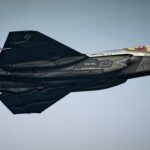Lockheed Martin’s F-35 is America’s most expensive weapons project. After fifteen years in development, the jet is still not ready for the fight the services expect. A confidential memorandum dated Aug 9 from Dr. Michael Gilmore, the Defense Department’s Director of Operational Test and Evaluation, warns that the fighter “is not on a path toward success.” His language is blunt. He states the program “will fail to deliver full Block 3F combat capability” before development is due to close in 2018, even though Congress has already approved nearly $400 billion for that work alone.
Gilmore’s memo landed a week after the Air Force declared the F-35A fit for limited combat. He disputes that claim. He writes that long-standing flaws in weapons employment, sensor fusion, electronic warfare, data links, and cybersecurity remain. He also says new faults appear faster than engineers can correct them. That trend, he argues, places combat testing – and the planned 2019 full-rate-production decision – at serious risk.
Lockheed F-35 Block 3F Capability Shortfalls
The memo details hard numbers. The program still tracks almost 1,000 open deficiency reports classed as “Category 1” or “Category 2,” the two highest danger tiers. Flight-control software resets mid-mission. Helmet-mounted displays blink or freeze. Radar tracks disappear when the pilot obliquely turns. Autonomic Logistics Information System (ALIS) faults ground aircraft unexpectedly. Cyber red-team intrusions succeed in minutes. None of those issues have permanent fixes.
The cost picture looks no prettier. The Joint Program Office pegs procurement at $391 billion for 2,443 U.S. aircraft, yet that figure excludes modernization such as Block 4 upgrades now being scoped. The services must also find at least $1 trillion for life-cycle sustainment. Gilmore cautions that each slip in the basic schedule pushes those totals higher, because units must absorb interim retrofit kits, extra software loads, and more depot time.
F-35 Weapon Systems and Combat Limitations
For commanders, capability gaps top the worry list. The present 3i software standard lets the F-35 carry only two weapons – the AIM-120C AMRAAM and the 500-pound JDAM – in limited attack profiles. Close-air-support troops cannot count on a functioning gun, because the internal 25 mm cannon still sprays shots well off centerline. Navy testers record poor ship-to-ship data flows over Link 16, handicapping cooperative targeting. Air Force evaluators find that the jet’s fuel bladder seals remain fragile after repeated hot refuels. Recent assessments have also pointed to engine-related vulnerabilities that could further limit operational readiness.
Fighter pilots who briefed Congress earlier in the summer described cockpit work-arounds that read like pre-production testing notes. One aviator said he powers the jet down between sorties to purge misleading threat symbols. Another runs his radar in a diagnostic mode for takeoff just to keep the display alive. “No other frontline fighter demands that sort of ritual,” he told staffers.
Lockheed Martin’s Response to F-35 TR-3 Concerns
Lockheed Martin says progress is steady. Company executives insist the third lot of Block 3F software will clear 88 percent of all open action items and will arrive by spring 2017. Joint Program Office chief Lt. Gen. Christopher Bogdan backs that schedule, adding that concurrency – the decision to start production years before testing ends – always anticipated retrofits. Critics answer that the concurrency bill now stands above $1.8 billion and continues to climb.
International partners feel the pain. Norway and the Netherlands have accepted their first aircraft yet must fund anti-ice upgrades, outer-wing modifications, and stable flight-control laws before declaring combat readiness. Australia notes that its jets still cannot employ the stand-off JSM missile central to Canberra’s defense posture. Israel remains the outlier; it has begun flight-testing its own avionics and calls its early buys “technology demonstrators.”
Congressional Oversight on F-35 Block 4 Modernization
Congress watches the back-and-forth with growing impatience. House Armed Services Committee members inserted language in the fiscal-year-2017 bill that withholds 25 percent of Block 4 development funds until the department delivers a realistic test and fielding plan. Senate appropriators direct the Pentagon to “reassess alternatives” if operational tests slip beyond 2019.
Gilmore’s memo maps a path to survival, not to cancellation. He recommends that program leaders:
- Freeze new production lots until Block 3F reliability metrics stabilize.
- Add 500 flight hours to operational test plans to capture edge-of-envelope data.
- Strengthen red-team cyber events to mirror theater-level attacks.
- Retain a dedicated fleet of pre-production aircraft solely for deficiency correction.
He concludes by stressing that the F-35 remains “salvageable” if the department acts now and resists optimistic scheduling. Otherwise, the jet risks entering service “without effective offensive or defensive capability against emerging threats.”
Lockheed Martin’s Response and Industry Perspective
Lockheed Martin officials disagree with the tone but not all the data. In a briefing to reporters, program vice-president Jeff Babione said the company “will never tolerate deficiencies” and “understands the stakes.” He pointed to recent 9-G maneuver trials that exceeded design margin and a 97 percent right-the-first-time factory score. Those numbers, he argued, signal a maturing line.
Air Combat Command chief Gen. Herbert “Hawk” Carlisle remains guarded. He told the Air Force Association that the F-35A’s initial capability “meets the limited tasks we gave it” but admitted that his squadrons still lean on legacy F-15Cs and F-16Cs for day-one suppression of enemy air defenses. Marine Corps Deputy Commandant for Aviation Lt. Gen. Jon Davis voiced similar caution. He said the F-35B can support ground troops “today” yet needs a working ALIS and stable Distributed Aperture System to unlock its full value.
All eyes now turn to the Operational Test and Evaluation master event list, due for revision in October. That list will drive flight-test allocations through 2018 and decide whether current budgets can stick. If planners compress events, they risk masking deficiencies. If they extend timelines, lawmakers may balk at further spending. Either choice cuts hard.
Industry analysts think the program has passed the political point of no return. With more than 180 jets already delivered and at least nine partner nations on contract, they argue that cancelation would cost more than repair. Yet they also note that sunk cost does not guarantee success. The B-2, Comanche, and Zumwalt programs each absorbed billions before cuts. The difference, they say, is the F-35’s worldwide customer base. Whether that base stays loyal depends on how convincingly Lockheed and the Pentagon close the current gaps. Some reports also suggest that manipulated flight test results may obscure the scale of these issues.
At the Pentagon, officials weigh an uncomfortable choice: slow down to fix the jet or push ahead and accept deferred capability. Gilmore’s memo gives them little room. He states that combat testing cannot begin while the jet’s shortfalls remain unresolved. Without that testing, he warns, the department cannot lawfully certify full-rate production. The decision falls to the next administration, which will judge whether the program’s promise justifies its cost and risk.
F-35 TR-3 Stealth Upgrade Emerges – Update March 2025
Nine years later, the Joint Strike Fighter still dominates defense headlines, though the cast has changed. Development never ended in 2018. Instead, the program slid into a rolling upgrade cycle now branded Tech Refresh 3, or TR-3. That hardware-and-software suite underpins the long-delayed Block 4 modernization, billed as the route to true fifth-generation performance.
On paper, TR-3 looks modest: faster processors, extra memory, a panoramic display, and new core avionics. In practice, everything in Block 4 hangs on it, from spectrum-sharing electronic warfare modes to internal carriage of anti-ship missiles. Lockheed installed TR-3 hardware on production lines starting in mid-2023, yet flight tests soon fell behind baselines. By January 2025 the DOT&E annual report called progress “significantly below plan” and faulted the JPO for software instability that forced multiple ground resets on every sortie.
Flight-test shortfalls triggered a one-year hold on F-35 deliveries. Nearly one hundred factory-fresh jets stacked up on aprons in Fort Worth and Cameri IT, waiting for a software load that would let pilots even taxi without screen freezes. The impasse broke in July 2024 when Lt. Gen. Michael Schmidt authorised a “truncated” package that restores basic navigation and flight control but withholds advanced sensor fusion. Contract penalties trimmed Lockheed’s margins, yet the company regained cash flow and promised to clear the backlog by early 2026.
Lockheed Martin Acknowledges TR-3 Upgrade Challenges
A May 2024 GAO audit projected life-cycle support at $1.58 trillion, up forty-four percent since 2018 despite smaller flying-hour goals. Lawmakers on both sides questioned whether the services can afford Block 4 weapons loads if each flight hour still tops $38,000 in 2025 dollars. The JPO replies that predictive maintenance algorithms and a planned ALIS-to-ODIN transition will chip at those figures once fleets migrate to TR-3, though it concedes savings remain “aspirational” until databases mature.
Even oversight entered flux. In May 2025 the Defense Secretary approved a sharp re-organization of DOT&E. The office now holds just forty-five billets and an “advisory” charter, a move critics say undercuts independent test authority precisely when the F-35 needs hard truths about its new code. Service chiefs counter that field commands own enough telemetry to judge combat readiness without a separate audit layer. Analysts note that Congress created DOT&E in 1983 for the same independence now at risk.
Still, progress shows up in the daily sortie sheet. The global fleet has passed 850,000 flight hours. Eleven air forces carry the jet on real alerts. Norwegian and Italian F-35As logged deterrence patrols over the High North during the 2024 Baltic crisis. Israeli F-35Is struck suspected air-defense nodes in Syria while dodging Russian radars. In each case pilots praise the jet’s stealth and sensor reach even while they complain about system crashes mid-mission.
F-35 Block 4 Software and Hardware Modernization Outlook
Lockheed pitches a path forward. Executives say full TR-3 capability will certify no later than March 2026, followed by phased Block 4 drops every six months. The company promises:
- Radar upgrades that quadruple synthetic-aperture mapping speed.
- A passive seeker for the AIM-260 Joint Advanced Tactical Missile.
- Seamless M-Code GPS for jam-dense theaters.
- Open-system gateways to host allied software modules without recertification.
Even optimists note that those features depend on stable core code and test aircraft that can fly steep envelopes without data-bus lockups. The Pentagon’s latest contract modification adds three flight-sciences jets to buttress the overtasked Edwards and Patuxent fleets – an echo of Gilmore’s 2016 call for dedicated deficiency hunters.
The customer base also widens. By March 2025, fifteen nations have F-35s on order or in service, and two – Greece and the Czech Republic – finalised letters of offer in the last six months. Lockheed targets 190 deliveries this calendar year, assuming software keeps pace. Its stretch goal: hit a drumbeat of twenty fighters per month by late-2025. That tempo mirrors Cold War F-16 peaks. Whether it proves sustainable hinges on chip supply, trained maintainers, and a cleared software pipeline.
Inside the cockpit, pilots finally glimpse improvements. A summer 2025 software push raises frame-rates on the helmet display, cures the long-standing jitter in night refueling, and tightens gun dispersion within spec. Marine aviators report that the Distributed Aperture System now overlays friendly positions in real time, easing urban close-support. Navy testers say the jet’s datalink passes raw sensor tracks to nearby E-2D Hawkeyes, closing a gap identified during 2022 carrier trials.
Yet the balance sheet still rules. Air Force leaders admit the jet costs more per hour than any other fighter in inventory. They plan to cut annual flying hours by ten percent and lean on advanced simulators to keep crews current. Congress signals it may cap the total U.S. buy near 1,700 jets instead of the original 2,443. Export demand might fill the line, but allies watch America for cues.
Program veterans see an irony. The F-35 now flies combat patrols while it fights for its own modernization. Gilmore’s 2016 memo predicted that reality when he warned deficiencies would outpace fixes. Nine years later the jet has advanced, yet his larger thesis holds: concurrency still forces operators to choose between fielding imperfect capability today or waiting for better code tomorrow. The difference in 2025 is scale. Hundreds of aircraft already sit on flight lines, and too many missions rely on them to pause. That urgency now drives every schedule and every dollar.
REFERENCE SOURCES
- https://www.airandspaceforces.com/first-f-35-block-4-updates-block-5/
- https://www.bloomberg.com/news/articles/2016-08-24/lockheed-s-f-35-still-falls-short-pentagon-s-chief-tester-says
- https://docs.pogo.org/publication/defense-monitor/2016/defense_monitor_july_sept_2016.pdf
- https://www.defenseone.com/business/2025/01/full-f-35-upgrade-package-might-not-happen-year-lockheed-says/402570/
- https://www.gao.gov/assets/gao-24-106909.pdf
- https://www.airandspaceforces.com/new-pentagon-report-f-35-test-progress-readiness/
- https://www.airandspaceforces.com/f-35-deliveries-can-resume-immediately-truncated-software/
- https://www.airandspaceforces.com/lockheed-deliver-190-f-35s-2025-secret-programs/
- https://www.defensenews.com/air/2025/03/04/f-35s-to-get-new-capabilities-with-summer-software-update/
- https://www.airandspaceforces.com/cut-to-dods-test-enterprise-alarms-critics-fearing-loss-of-honest-broker/
- https://armyrecognition.com/news/aerospace-news/2025/breaking-news-lockheed-martin-completes-tr-3-upgrade-to-turn-the-f-35-into-an-even-deadlier-stealth-fighter-jet



